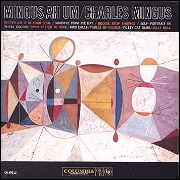The variety of Charles Mingus's music and his gifts as a writer can be heard on Mingus Ah Um, his best-selling record and perhaps the one that is artistically most satisfying. A few years earlier he had outlined his compositional and rehearsal methods:
"My whole conception with my present Jazz Workshop group deals with nothing written. I 'write' compositions--but only on mental score paper--then I lay out the composition part by part to the musicians. I play them the 'framework' on piano so that they are all familiar with my interpretation and feeling and with the scale and chord progressions to be used. Each man's particular style is taken into consideration, both in ensemble and in solos. For instance, they are given different rows of notes to use against each chord but they choose their own notes and play them in their own style, from scales as well as chords, except where a particular mood is indicated. In this way I can keep my own compositional flavor in the pieces and yet allow the musicians more individual freedom in the creation of their group lines and solos."
As a result of this approach, the musicians on Mingus Ah Um sound particularly at home in the music, with a looseness in improvising countermelodies and a layered sound that surely comes form Mingus's methods--though the soloist's concision was a result of careful editing after the recording date. The band itself is a powerhouse, featuring John Handy's sweet-and-sour alto, Booker Ervin's fiery preaching on tenor, Horace Parlan's funky, chordal approach to the piano, and Jimmy Knepper's avant-gutbucket trombone.
It kicks off with "Better Git It In Your Soul," a gospel-based number, mostly in 6/4 time, underpinned by driving riffs and Mingus's shouts of "Lawd, I know!" "Goodbye Pork Pie Hat" (dedicated to Lester Young) is a lament showcasing a mournful tenor solo by Handy that includes some effective flutter tonguing.
"Boogie Stop Shuffle," also in the minor mode, incorporates elements suggested by its title and includes a roaring Ervin outing, while "Self-Portrait in Three Chords" is one of Mingus's deliriously romantic Ellington-style ballads, complexly voiced with interweaving contrapuntal lines. "Open Letter to Duke" rounds out the first side, beginning with some of Ervin's high-octane blowing over a shuffle beat and then segueing into a languid, filmy ballad led by Handy's alto, another shuffle episode, and finally a Latin vamp.
Side two starts with "Bird Calls," an up-tempo tribute to Charlie Parker, with fierce Ervin and liquid-toned Handy. "Fables of Faubus" is a loping, medium-tempo minor theme, played against a descending run on the bass. All the soloists smoke on this one; Handy is gutsy yet lithe, Parlan is sublimely bluesy, contributing a carefully constructed statement full of unexpected turns, and Ervin wails.
"Pussy Cat Dues," a slow blues, offers a glimpse of Handy's clarinet playing and Knepper's dirty, deliciously vocal trombone. The album ends with "Jelly Roll," an affectionate tribute to Jelly Roll Morton that effectively contrasts an old-fashioned, bouncy two-beat with straight-ahead 4/4 modern jazz blowing.
In its abundance of memorable compositions and its multiple references to the Afro-American tradition in such varied aspects, Mingus Ah Um is a kind of summation of everything Mingus could do. It is also a quintessential hard-bop session, having all the qualities typical of the school: heavier use of the minor mode and strong rhythmic patterning, along with slower tempos, blues- and gospel-influence phrasing and compositions, and sometimes lusher melodies.
Mingus, of course, was as "unique" as Monk; that is, each possessed an immediately recognizable sensibility and approach. But then that's what makes Mingus Ah Um a high point of hard bop rather than a "typical" hard-bop date.
--DAVID H. ROSENTHAL, Hard Bop,
Oxford University Press, 1992




